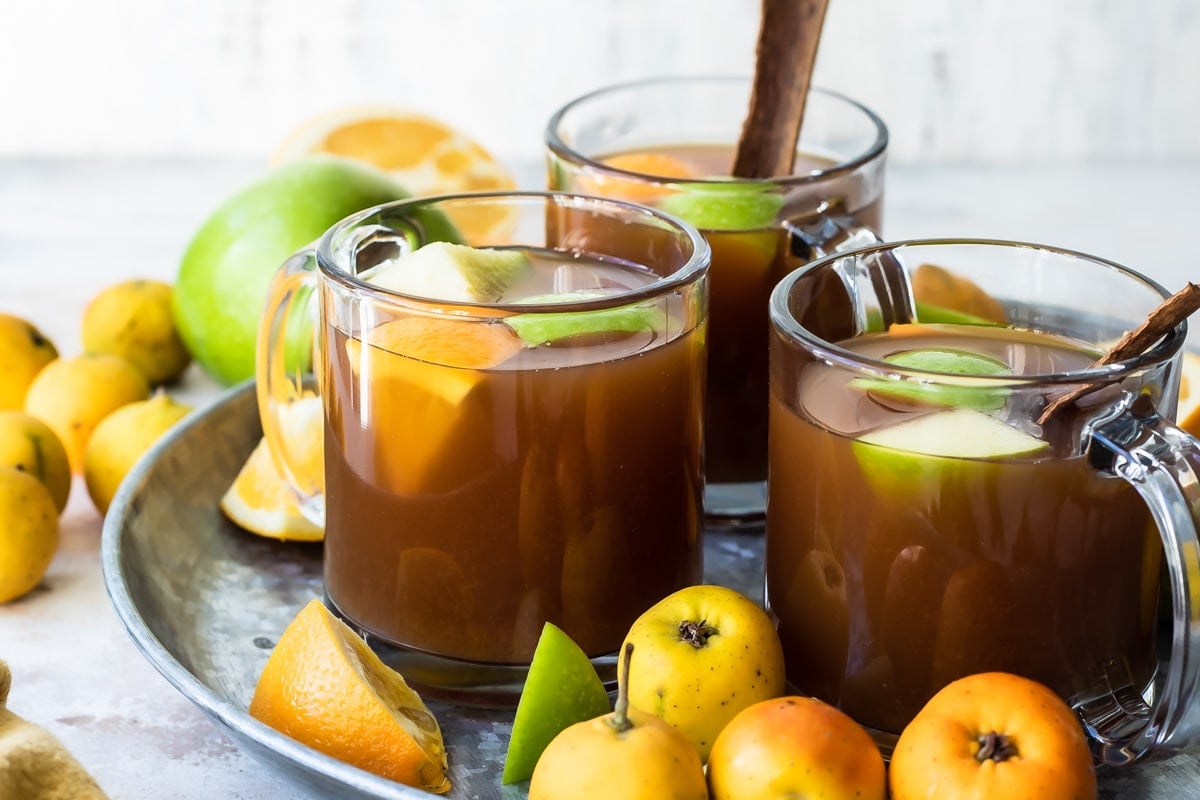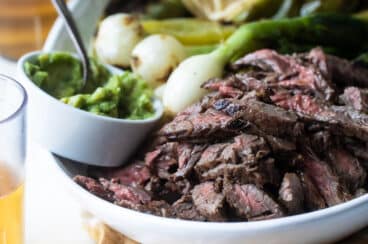This post may contain affiliate links. For more information, please see our affiliate policy.
Pozole Rojo is a classic Mexican recipe made with pork or chicken, hominy, and vegetables in a guajillo chile broth. Because it is inexpensive to make and so delicious, Mexicans enjoy this soup for holidays and parties all year round.

Pozole Rojo
My husband is a born-and-bred Mexican, and he has strong opinions on Pozole Rojo. This is the recipe that has been passed down through the generations in his small town in Aguascalientes, and I’m so excited to share it with you.
Pozole can be red (pozole rojo) or green (pozole verde), and this version gets its red color from dried guajillo chillies, a pungent pepper with a strong but mild taste. Guajillos red chiles are not spicy. The soup can be made with pork or chicken, but never both, and never with beef.
This traditional Mexican soup is popular for Christmas, New Year’s Eve, and Mexico’s Independence Day on September 15th. Natives also make it year-round for parties because it is economical, flavorful, and always a hit.
Serve Pozole Rojo with fresh garnishes like shredded lettuce or cabbage, minced cilantro, minced white onion, sliced radishes, diced avocados, and ripe lime wedges for squeezing. A pinch of dried Mexican oregano is welcome, too! Offer plenty of crunchy tostadas on the side.
Table of Contents

At a Glance: Here is a quick snapshot of what ingredients are in this recipe.
Please see the recipe card below for specific quantities.
Pozole Recipe Ingredients
- Pork: Either pork shoulder or pork butt can work here. For the most flavorful soup, look for bone-in pork. Trim the largest pieces of fat from the roast and then chop into small pieces. Add any bones to the pot, too.
- Cold water: Always start with cold water. This helps keep the broth clear, not cloudy. The amount of water used and the length of simmering time will determine the intensity of the broth.
- Guajillo chiles: These dried chiles are available at Mexican grocery stores or online. There is no substitute for guajillo chiles. The chiles can be soaked the night before if desired.
- Hominy: Look for hominy in a can that is already cooked through. If you decide to use dried hominy, cook it separately according to the package instructions (it can take several hours).
How to Make Pozole Soup
To make the pork broth:
- To a Dutch oven or large stockpot, add pork pieces, any bones, and cold water to cover. Over medium-high heat, bring to a boil. Immediately reduce heat to low and skim the foam off the top.

- To the pot add onion, garlic, and salt. Simmer gently (bubbles should barely break the surface at irregular intervals) until the pork is cooked throughly, at least 1 ½ hours or up to 2 hours. The longer the broth simmers, the more flavor it will have.

- Remove pork from the pot to a rimmed baking sheet or large bowl. Discard any bones. Reserve 3 cups pork broth and pour through a fine-mesh strainer over a bowl. Set aside and discard the remaining broth or strain and reserver for another use.

To make the chile sauce:
- While the pork is cooking, cut the dried chiles open with kitchen scissors or a paring knife and remove the seeds and the stem. Cut into 1-inch pieces and add to a medium bowl.

- Add boiling water to cover and soak for at least one hour or overnight.

- Reserve 1 cup soaking liquid from the chiles and drain the rest. To a blender, add the reconstituted chiles, garlic, cumin seeds, and reserved water and blend until smooth.

- Pour through a fine-mesh strainer set over a bowl. Discard any solids. You should have 1 cup chile sauce (add water to reach 1 cup if needed).

To make the soup:
- Return the reserved 3 cups pork broth to the pot. Add 4 cups water and chile sauce. Bring to a boil, then add pork meat and hominy. Simmer until heated through, about 10 minutes.

- Add salt and pepper to taste (I like at least 2 teaspoons salt and 1 teaspoon pepper). Serve with lettuce, lime slices, cilantro, onions, radishes, oregano, and tostadas or corn tortillas.

Red Pozole Recipe Tips
- Yield: This recipe makes 12 cups of soup, enough for 6 servings, 2 cups each.
- Make ahead: Cook the pork to make the broth up to 3 days in advance and store covered in the refrigerator. You can also soak the guajillo chilies a few days in advance and blend up the sauce.
Pozole Recipe Serving Suggestions
Pozole Rojo is a quintessential Christmas and New Year’s recipe. Adding extra hominy to the soup makes it easy to stretch for large groups, while a little pork (or chicken) makes it extra special. Because it’s less expensive than meat-focused dishes, it’s also served year round.
This soup is traditionally served with shredded lettuce or cabbage, fresh cilantro leaves, minced white onion, sliced radishes, diced avocados, diried Mexican oregano, lime wedges, and tostadas or tortilla chips.
Storing Leftover Pozole Soup
Store leftovers covered in the refrigerator for up to 4 days.
To Freeze Pozole Rojo
Pack cooled pozole (minus all the garnishes) into freezer-safe containers leaving 1-inch headspace for expansion. Label, date, and freeze for up to 2 months. Thaw overnight in the refrigerator and reheat to 165 degrees on the stove or in the microwave.

Frequently Asked Questions
Pozole rojo is made from tender pork or chicken, hominy, and a red chile sauce made with guajillo chiles. The chiles are what give the soup its signature red color. Guajillo chiles are not spicy, and neither is the soup.
Red pozole is a Mexican soup that has a savory pork broth with guajillo chiles and a crunchy texture from hominy. Guajillo chiles have a distinctive taste that is bright and fruity but not spicy. Green pozole (pozole verde) is made with tomatillos, roasted jalapeños or serranos, and epazote.
Pozole (posole) is a soup made with pork or chicken and guajillo chiles while hominy is an ingredient in posole. Hominy is a dried field corn product that has been cured with lye. You can find it dry although it takes a very long time to cook. So, I recommend seeking out canned hominy which just needs to be heated through once drained.
No other chile will have the same authentic taste as guajillo chiles. Substituting another dried chile, such as ancho chiles or chile de arbol, is not recommended (at least not if you want the correct flavor and heat).
More authentic Mexican recipes
Mexican Recipes
Chicken Tinga
Mexican Recipes
Salsa de Birria
Mexican Recipes
Carne Asada
Mexican Recipes
Tacos Al Pastor Recipe
Join Us

Pozole Rojo
Ingredients
For the pork broth:
For the chile sauce:
- 1 ounce dried guajillo chiles (see note 3)
- boiling water to cover
- 1 clove garlic peeled
- 1/8 teaspoon cumin seeds
For the soup:
- 4 cups water
- 2 (15.5-ounce) cans hominy drained and rinsed (see note 4)
- Shredded lettuce , lime slices, minced fresh cilantro, minced white onion, sliced radishes, dried Mexican oregano, and tostadas, for serving
Instructions
To make the pork broth:
- To a Dutch oven or large stock pot, add pork pieces, any bones, and cold water to cover. Over medium-high heat, bring to a boil. Immediately reduce heat to low and skim the foam off the top.
- To the pot add onion, garlic, and salt. Simmer gently (bubbles should barely break the surface at irregular intervals) until the pork is cooked throughly, at least 1 ½ hours or up to 2 hours. The longer the broth simmers, the more flavor it will have.
- Remove pork from the pot to a rimmed baking sheet or large bowl. Discard any bones. Reserve 3 cups pork broth and pour through a fine-mesh strainer over a bowl. Set aside and discard the remaining broth or strain and reserver for another use.
To make the chile sauce:
- While the pork is cooking, cut the dried chiles open with kitchen scissors or a paring knife and remove the seeds and the stem. Cut into 1-inch pieces and add to a medium bowl. Add boiling water to cover and soak for at least one hour or overnight.
- Reserve 1 cup soaking water from the chiles and drain the rest. To a blender, add the reconstituted chiles, garlic, cumin seeds, and reserved water and blend until smooth. Pour through a fine-mesh strainer set over a bowl. Discard any solids. You should have 1 cup chile sauce (add water to reach 1 cup if needed).
To make the soup:
- Return the reserved 3 cups pork broth to the pot. Add 4 cups water and chile sauce. Bring to a boil, then add pork meat and hominy. Simmer until heated through, about 10 minutes.
- Add salt and pepper to taste (I like at least 2 teaspoons salt and 1 teaspoon pepper). Serve with lettuce, lime slices, cilantro, onions, radishes, oregano, and tostadas.
Notes
- Pork: Either pork shoulder or pork butt can work here. For the most flavorful soup, look for bone-in pork. Trim the largest pieces of fat from the roast and then chop into small pieces. Add any bones to the pot, too.
- Cold water: Always start with cold water. This helps keep the broth clear, not cloudy. The amount of water used and the length of simmering time will determine the intensity of the broth.
- Guajillo chiles: These dried chiles are available at Mexican grocery stores or online. There is no substitute for guajillo chiles. The chiles can be soaked the night before if desired.
- Hominy: Look for hominy in a can that is already cooked through. If you decide to use dried hominy, cook it separately according to the package instructions (it can take several hours).
- Yield: This recipe makes 12 cups of soup, enough for 6 servings, 2 cups each.
- Storage: Store leftovers covered in the refrigerator for up to 4 days.
Nutrition
Meggan Hill is a classically-trained chef and professional writer. Her meticulously-tested recipes and detailed tutorials bring confidence and success to home cooks everywhere. Meggan has been featured on NPR, HuffPost, FoxNews, LA Times, and more.



